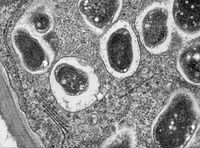
Photo from wikipedia
The objective of this investigation was to evaluate the impact of seed priming with seaweed liquid extracts (SLEs) prepared from three Egyptian seaweeds ( Ulva fasciata , Cystoseira compressa ,… Click to show full abstract
The objective of this investigation was to evaluate the impact of seed priming with seaweed liquid extracts (SLEs) prepared from three Egyptian seaweeds ( Ulva fasciata , Cystoseira compressa , and Laurencia obtusa ) in a concentration of 20 g L -1 on seed germination and seedling growth of Vigna sinensis and Zea mays as well as the effectiveness of these extracts in ameliorating salinity stress. Laurancia extract (LLE) induced the maximum positive response in germination as well as producing the maximum increases in all seedling morphological parameters with percent of response 87.14% for hypocotyl growth of V. sinensis and 85.71% coleoptile elongation of Z. mays. The maximum amylase and protease activities were recorded with LLE priming. Ulva , Cystoseira , Laurencia liquid extract consortium (UCLLE) induced the highest promotion effect for both V. sinensis and Z. mays giving significant increments for all growth criteria, dry biomass 0.301 and 0.438 g seedling -1 , Chl a 18.98 and 13.79 mg g -1 FW, total carbohydrates 460.88 and 518.14 g seedling -1 , protein 219.72 and 207.49 g seedling -1 respectively. Seeds primed with UCLLE consortium exhibited remarkable tolerance for salinity stress, meanwhile the highest ameliorating effect was pronounced with 10% SW supplementation. Priming with SLEs enhances the growth of either V. sinensis or Z. mays under salinity stress, whereas UCLLE consortium induced significant increases in biomass 0.231 and 0.379 g seedling -1 , respectively. Seed priming with SLEs enhanced guaiacol peroxidase activity giving the highest value with UCLLE consortium conjugated with 25% SW (12.47 and 13.05 μmol min -1 g -1 FW), respectively. Application of Canonical Corresponding analysis (bi-plot) demonstrates a significant correlation between variables of SLEs components and germination indices of the two plants concluding total nitrogen, total phosphorous, potassium, ascorbic acid, and amino acids besides carbohydrate content. Therefore, results maintain the concept of SLEs as agricultural biocatalyst which could be practiced as prospective biostimulants for being feasible, sustainable, eco-friendly, and effective in improving salinity tolerance for some plants.
Journal Title: Journal of Applied Phycology
Year Published: 2021
Link to full text (if available)
Share on Social Media: Sign Up to like & get
recommendations!